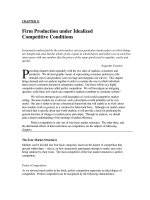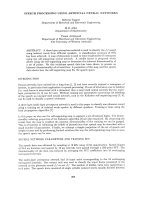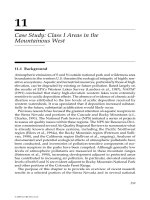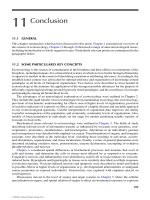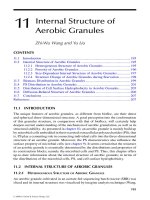Multicultural chapter 11
Bạn đang xem bản rút gọn của tài liệu. Xem và tải ngay bản đầy đủ của tài liệu tại đây (129 KB, 22 trang )
CHAPTER 11
RACIAL/CULTURAL
IDENTITY DEVELOPMENT
IN PEOPLE OF COLOR:
THERAPEUTIC
IMPLICATIONS
Background
These models acknowledge within-group
differences and have implications for treatment.
The high failure-to-return rate of many clients
seems to be intimately connected to the mental
health professional’s inability to assess the
cultural identity of clients accurately.
These models also acknowledge sociopolitical
influences in shaping minority identity.
RACIAL IDENTITY
ASSUMPTIONS
1. Racism is a basic and integral part of U.S. life and
permeates all aspects of our culture and institutions.
2. Persons of color are socialized into U.S. society and,
therefore, are exposed to the biases, stereotypes, and racist
attitudes, beliefs, and behaviors of the society.
3. The level of racial identity development consciousness
affects the process and outcome of interracial interactions.
RACIAL IDENTITY
ASSUMPTIONS
4.
How people of color perceive themselves as racial beings
seems to be strongly correlated with how they perceive and
respond to racial stimuli. Consequently, race-related reality
represents major differences in how they view the world.
5. It seems to follow an identifiable sequence. There is an
assumption that people of color who are born and raised in
the United States may move through levels of consciousness
regarding their own identity as racial beings.
6. The most desirable development is a multicultural
identity that does not deny or negate one’s integrity.
The Racial/Cultural Identity
Model (Sue & Sue, 1999)
1. Conformity
2. Dissonance
3. Resistance and Immersion
4. Introspection
5. Integrative Awareness
Self/Other Perceptions
1. Attitude and Beliefs toward Self
2. Attitudes and Beliefs toward Members of the Same
Minority
3. Attitudes and Beliefs toward Members of Different
Minorities
4. Attitude and Beliefs toward Members of the Dominant
Group
PHASE 1-CONFORMITY
Is marked by desire to assimilate and acculturate–buys into the
melting pot analogy.
Accepts belief in White superiority and minority inferiority.
Unconscious and conscious desire to escape one’s own racial
heritage.
Validation comes from a White perspective.
Role models, lifestyles, and value systems all follow the dominant
group.
CONFORMITY
Physical and cultural characteristics identified with one’s
own racial/cultural group are perceived negatively, as
something to be avoided, denied, or changed.
Physical characteristics (black skin color, “slant-shaped
eyes” of Asians), traditional modes of dress and appearance,
and behavioral characteristics associated with the minority
group are a source of shame.
There may be attempts to mimic what are perceived as
White mannerisms, speech patterns, dress, and goals.
Low internal self-esteem is characteristic of the person.
CONFORMITY
These individuals may have internalized the
majority of White stereotypes about their group. In
the case of Hispanics, for example, the person may
believe that members of his or her own group have
high rates of unemployment because “they are lazy,
uneducated, and unintelligent.”
The denial mechanism most commonly used is “I’m
not like them; I’ve made it on my own; I’m the
exception.”
CONFORMITY
People believe that White cultural, social, institutional
standards are superior. Members of the dominant group are
admired, respected, and emulated. White people are believed
to possess superior intelligence.
Some individuals of color may go to great lengths to appear
White. In The Autobiography of Malcolm X, Malcolm X
relates how he would straighten his hair and primarily date
White women.
Reports that Asian women have undergone surgery to reshape
their eyes to conform to White female standards of beauty
may (but not in all cases) typify this dynamic.
PHASE 2-DISSONANCE
People experience breakdown of denial system.
They encounter information discordant with previous beliefs
in the conformity stage.
Dominant-held views of minority strengths and weaknesses
begin to be questioned.
They begin to realize that attempts to assimilate or
acculturate may not be fully allowed by larger society.
DISSONANCE
There is now a growing sense of personal
awareness that racism does exist, that not all aspects
of the minority or majority culture are good or bad,
and that one cannot escape one’s cultural heritage.
Feelings of shame and pride are mixed in the
individual, and a sense of conflict develops.
PHASE 3–RESISTANCE
AND IMMERSION
“Why should I feel ashamed of who and what I am?”
Begins to understand social-psychological forces associated
with prejudice and discrimination.
Extreme anger at perceived cultural oppression.
May be an active rejection of the dominant society and culture.
Members of the dominant group are viewed with suspicion.
RESISTANCE AND
IMMERSION
Oriented toward self-discovery of one’s own history and
culture. There is an active seeking out of information and
artifacts that enhance that person’s sense of identity and
worth.
Cultural and racial characteristics that once elicited feelings
of shame and disgust become symbols of pride and honor.
“Why should I be ashamed of who and what I am?”
Phrases such as “Black is beautiful” represent a symbolic
relabeling of identity for many Blacks. Racial self-hatred
becomes something actively rejected in favor of the other
extreme, which is unbridled racial pride.
RESISTANCE AND
IMMERSION
There is a feeling of connectedness with other members of
the racial and cultural group and a strengthening of new
identity begins to occur. Members of one’s group are
admired, respected, and often viewed now as the new
reference group or ideal. Cultural values of the minority
group are accepted without question.
As indicated, the pendulum swings drastically from original
identification with White ways to identification in an
unquestioning manner with the minority-group’s ways.
Persons in this stage are likely to restrict their interactions as
much as possible to members of their own group.
RESISTANCE AND
IMMERSION
There is also considerable anger and hostility directed
toward White society. There is a feeling of distrust and
dislike for all members of the dominant group in an almost
global anti-White demonstration and feeling.
White people, for example, are not to be trusted for they are
the oppressors or enemies. In extreme form, members may
advocate complete destruction of the institutions and
structures that have been characteristic of White society.
PHASE 4-INTROSPECTION
Increased discomfort with rigidly help group views (i.e., all
Whites are bad).
Too much energy directed at White society and diverted from
more positive exploration of identity questions.
Conflict ensues between notions of responsibility and allegiance
to one’s minority group and notions of personal autonomy.
Attempts to understand one’s cultural heritage and to develop an
integrated identity.
INTROSPECTION
The conflict now becomes quite great in terms of
responsibility and allegiance to one’s own minority
group versus notions of personal independence and
autonomy.
The person begins to spend more and more time
and energy trying to sort out these aspects of selfidentity and begins to increasingly demand
individual autonomy.
PHASE 5–INTEGRATIVE
AWARENESS
Develop inner sense of security as conflicts between new and old
identities are resolved.
Global anti-White feelings subside as person becomes more
flexible, tolerant, and multicultural.
White and minority cultures are not seen as necessarily conflict.
Able to own and accept those aspects of U.S. culture seen as
healthy and oppose those that are toxic (racism and oppression).
INTEGRATIVE AWARENESS
Develops a positive self-image and experiences a strong sense of selfworth and confidence.
Not only is there an integrated self-concept that involves racial pride in
identity and culture, but the person develops a high sense of autonomy.
Becomes bicultural or multicultural without a sense of having sold out
one’s integrity.
In other words, the person begins to perceive himself or herself as an
autonomous individual who is unique (individual level of identity), a
member of one’s own racial-cultural group (group level of identity), a
member of a larger society, and a member of the human race (universal
level of identity).
Implications for
Clinical Practice
Be aware that the R/CID model should be viewed as
dynamic, not static.
Do not fall victim to stereotyping in using these
models.
Know that minority development models are
conceptual aids and that human development is much
more complex.
Know that identity development models begin at a
point that involves interaction with an oppressive
society.
Implications for
Clinical Practice
Be careful of the implied value judgment given in
almost all development models.
Be aware that racial/cultural identity development
models seriously lack an adequate integration of
gender, class, sexual orientation, and other
sociodemographic group identities.
Know that racial/cultural identity is not a simple,
global concept.
Begin to look more closely at the possible therapist
and client stage combinations.
